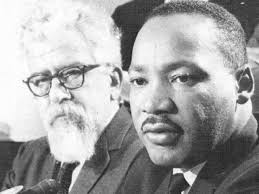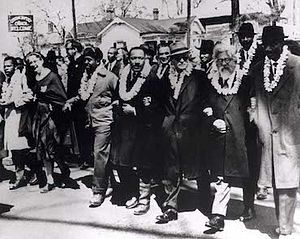 Notes from the Lampert Library
Notes from the Lampert Library
by Aileen Grossberg
Congregant, Librarian Shomrei Emunah
In just a few weeks on March 21 the nation will mark the 50th anniversary of the landmark 3rd march from Selma to Montgomery, Alabama. This event has been memorialized in Jewish lore by the famous picture of Martin Luther King, Ralph Bunche and Rabbi Abraham Joshua Heschel, linked arm-in-arm in the leading row of marchers.
While most of the initial 8000 marchers were African Americans, some were white, Asian or Latino. Religious leaders of many faiths marched with King to show solidarity.
Heschel later said that “When I marched in Selma, my feet were praying.” Heschel had first met King in 1963 at a conference in Chicago. He said that racism was like “an eye disease” which makes it difficult to see the holy sparks in other people. They shared their love of Bible and a belief that religious leaders had a responsibility to stand up for others. They became so close that in 1968 at the Jewish Theological Seminary’s celebration of Heschel’s birthday, King was asked to speak. He said that Heschel was “one of the true great men of our age, a truly great prophet.”
Not long afterwards, King was assassinated. Heschel spoke at King’s funeral.
Although some Jewish leaders spoke out and participated in the early Civil Rights movement- often inspired by Heschel- many Jews were reluctant to commit themselves. Others, both clergy and laymen especially in the South, did not support the efforts of King and like-minded leaders.
 The film Selma has been released in time to mark this 50th anniversary. There has been some debate in the Jewish press about not giving enough credit to the Jewish (and white) participation in the Selma march and support for the Civil Rights Movement in general. However, many individuals have commented that this is not a Jewish story. They point out that the story of Selma and the other efforts involved in the Civil Right Movement are part of the story of the fight for rights for African Americans.
The film Selma has been released in time to mark this 50th anniversary. There has been some debate in the Jewish press about not giving enough credit to the Jewish (and white) participation in the Selma march and support for the Civil Rights Movement in general. However, many individuals have commented that this is not a Jewish story. They point out that the story of Selma and the other efforts involved in the Civil Right Movement are part of the story of the fight for rights for African Americans.
History is a compilation of stories told from many points of view. In addition, the viewer must remember that this is a movie, perhaps with some educational value, but primarily meant to entertain and evoke emotion. This film is not a documentary which one would hope would be objective and would cite its sources.
The critics have generally applauded Selma (It rates an 89 on Metacritic.com, a site that compiles reviews from scores of sources.)
One view of the Jewish connection to the march on Selma is contained in Richard Michelson’s simply told and beautifully illustrated picture book, As Good as Anybody: Martin Luther King Jr and Abraham Joshua Heschel’s Amazing March Toward Freedom.” Another book is Abraham Joshua Heschel by Or N. Rose, with a foreword by Susannah Heschel, Abraham Joshua Heschel’s daughter. (black and white photos)
- Is It Passover Yet? - Thu, Apr 18, 2024
- MESH Report April 9, 2024 - Thu, Apr 11, 2024
- Guess Who? - Wed, Mar 13, 2024
